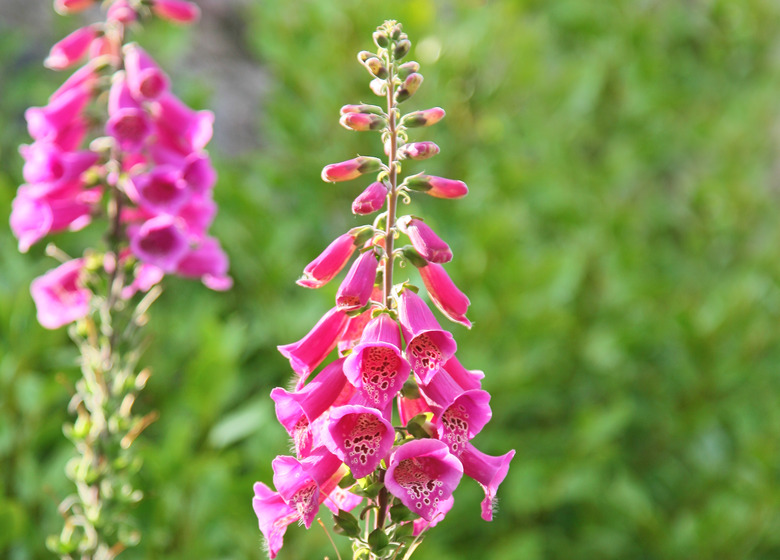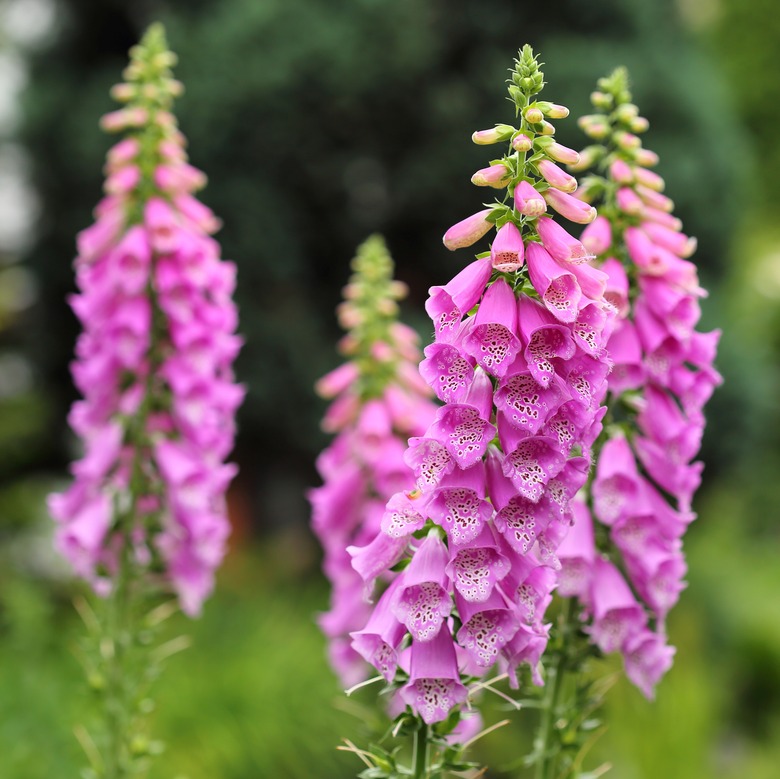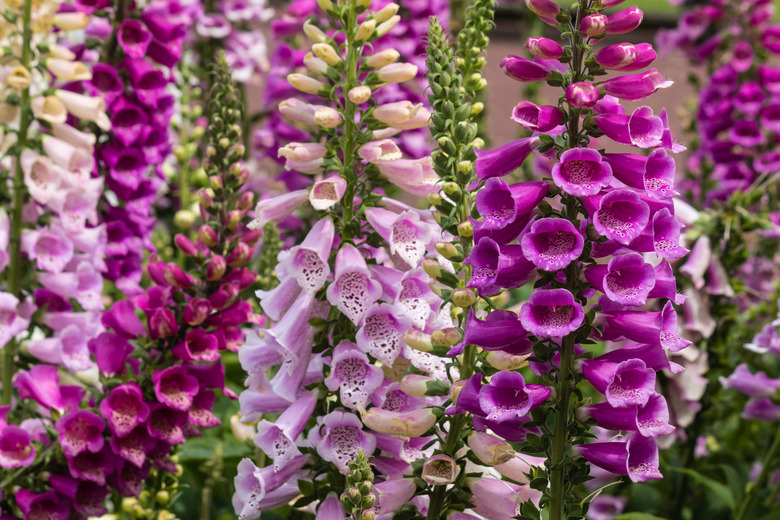How To Grow Foxglove
We may receive a commission on purchases made from links.
Foxglove (Digitalis spp.) is a genus of about 20 herbaceous perennials, shrubs, and biennials that grow vertically and display colorful, bell-like flowers. Those of the purple foxglove (Digitalis purpurea, USDA zones 4-9), a common ornamental, are purple, while those of the rusty foxglove (Digitalis ferruginea, zones 4-8), which is native to Turkey, Hungary and the Caucasus, are rust-colored and those of the sunset or willow-leaved foxglove (Digitalis obscura, zones 4-8), which grows in Spain and Africa, are red. Coloration aside, all foxgloves grow tall and stately and are widely cultivated so their showy flowers can be appreciated by gardeners everywhere.
Flowering foxglove plants are biennial and produce flowers only during the second growth season. During the first year, they produce a large, leafy rosette that overwinters and produces slender flower spikes the following spring. Foxglove flowers are magnets for hummingbirds and bees, which the plant needs for cross-pollination, and its tubular flowers are shaped in such a way to make it easy for bees to land and forage. The number of flowers peaks in early summer, when bees are most active, and because foxglove plants can grow to 6 feet in height, bees have no trouble finding them. The height of the foxglove plant and its showy flowers make it a favorite of flower gardeners despite the fact that it's literally a killer.
The common name "foxglove" doesn't refer to foxes or gloves at all; it comes from the Anglo-Saxon name "folks-glew," which means "fairy bells" in reference to the bell-shaped flowers. The scientific name "digitalis" refers to the fingerlike shape of these flowers, and it's also the name for a group of medicines derived from the leaves.
Best Uses for Foxglove
Best Uses for Foxglove
While foxglove plants are cultivated in large numbers for the pharmaceutical industry, gardeners should plant them exclusively for ornamentation. They provide vertical interest, and they provide a framework for lower-growing species at the back of a cottage garden. They typically reach their peak of coloration in June, after which the flowers wilt as they produce seeds that will germinate the following year and produce more plants.
Foxglove prefers full sun, but it can tolerate shade and can grow along with other shade-tolerant species, such as bellflowers, geraniums and garden phlox, to create a rainbow of color to adorn your garden. They can also be combined with ferns, hostas and a stately pine tree to produce a woodland setting, and for a particularly dramatic setting, different-colored species of foxgloves can be combined in groups. Foxgloves aren't particularly drought tolerant, so they need to be in a part of the garden that gets regular watering.
Because foxgloves grow so tall, the stalks can bend under the weight of the foliage, so they sometimes need staking. When the flowers are finished blooming, removing the central flower stalk encourages new growth, and the plant may produce a second round of flowers. Once all the flowers have gone to seed and are spent, which happens during the second year, the plants should be removed from the garden to make way for new plants the following spring, and once the seeding cycle starts, the garden should have flowers every year. Keeping in mind that the plants are toxic even when dead, take care to dispose of them properly. Do not throw them on the compost pile.
How to Grow Foxglove
How to Grow Foxglove
How to Start Foxglove From Seed
Foxglove is very easy to start from seed. The seeds need light to germinate, so you basically just scatter them over the soil and rake very lightly to partially bury them. (That's essentially how the plants propagate themselves if you allow the flowers to go to seed.) Keep the soil moist until the seeds germinate and when the seedlings emerge, thin them to a spacing of 18 to 24 inches.
If you start seeds indoors, the seedlings need to be hardened off before being transplanted outdoors by being placed in a sheltered outdoor location with protection from sun, wind and frost. Plant them in well-turned soil fortified with compost and other organic material. Choose a cloudy day for transplanting to minimize the risk of transplant shock.
In What Zone Does Foxglove Grow Best?
In What Zone Does Foxglove Grow Best?
Foxglove thrives in a combination of sun and shade and doesn't do well in the intense sunlight of Southern growing zones. They grow best in full sun in USDA hardiness zones 4 through 8, but if you give them plenty of shade, they may also prosper in zones 9 and 10. Locations in zone 3 that receive ample sunlight in the summer can also potentially support foxglove, especially if you start the plants indoors and transplant them in the spring as soon as conditions are right.
When Should You Plant Foxglove?
When Should You Plant Foxglove?
The best time to sow foxglove seeds outdoors is in the early spring after all danger of frost has passed. If you prefer to get a jump on the season, start them indoors eight to 10 weeks before the last frost. The ideal soil temperature for germination is 60 to 65 degrees Fahrenheit, and when the seedlings emerge, provide 16 hours of light a day using grow lights. If you start the seeds in cells, transplant them to larger pots when they develop two true leaves so the roots have space to grow before being transplanted outside.
Soil, Sunlight, and Water Recommendations for Foxglove
Soil, Sunlight, and Water Recommendations for Foxglove
Foxglove grows well on acidic soil and will flourish in soil with a pH between 4.5 and 8.3. If a test reveals that the soil is too alkaline, bring down the pH by working in some peat moss or, in extreme circumstances, sulfur. Unfortunately, weeds also like acidic soil, so don't overdo it and be on the lookout for them. Foxglove likes rich soil made fertile by turning in compost and other organic material at the time of planting.
Foxglove is a woodland plant that doesn't mind being overshadowed by trees and larger plants, but its preference is for full sun. However, it can be scorched in very hot weather, so in warmer climates, it's best to plant it in a semishaded spot. The soil must be kept moist; foxglove is not drought tolerant and needs about 1 inch of water per week. If you don't get that much rainfall, water your foxglove plants regularly.
How to Propagate Foxglove
How to Propagate Foxglove
You can allow foxglove flowers to go to seed, and the plants will self-propagate quite reliably, but if you want to grow them in a different location, you can use one of three methods. You can collect the seeds and sow them on your chosen site; you can cut the flower stalk in half and replant the top part; or you can replant the leaves. The leaves to use for propagating new plants are the tiny ones growing from the main stalk that already have tiny white roots attached, not the large ones forming the basal rosette. Plant the stalk or leaf directly on moist, rich soil and water regularly until the roots get established
How to Winterize Foxglove
How to Winterize Foxglove
Because foxglove is a biennial that flowers only in its second year, the basal rosette must survive the winter. It will go dormant in cold climates with sub-zero temperatures, but the frozen ground may heave up the plant and damage the roots. Prevent this by laying a layer of mulch and be sure to remove it in the spring when the ground thaws.
How to Harvest Foxglove
How to Harvest Foxglove
The entire foxglove plant is poisonous, even when it's dead, so you'll never harvest it for food, but you may want flowers for your dining table arrangement. The best time to pick a spike of foxglove flowers is when one-third of the flowers on the spike are open. The rest will open in the vase.
If you want to harvest foxglove seed, wait until the flowers have wilted and the spike starts to turn brown. Collect the pods individually, put them in a bowl and set the bowl in a dry place. When they are completely dry, shake the seeds into the bowl and store them in a jar. If you want more seeds with less effort, cover the spike with cheesecloth and wait for the pods to start opening. Then, pull out the spike, hold it upside down and shake the seeds into the cheesecloth.
Common Pests and Other Problems for Foxglove
Common Pests and Other Problems for Foxglove
Foxglove may be toxic to mammals, but some insects and mollusks think the leaves and flowers are delicious, and they also use the leaves for shelter. Any flower gardener will recognize the usual suspects, including:
- Aphids: These tiny bugs congregate on the underside of leaves in large numbers and leave a sticky excrement called honeydew that attracts ants. Aphids suck the juices from the leaves, so they have to go. You can often dislodge them from leaves with a spray of water, or you can kill them with insecticidal soap. Attracting predators, such as ladybugs, is an effective long-term solution.
- Mealybugs: These bugs are tiny, and they also excrete honeydew. They are very similar to aphids, and you handle them the same way. Spray water or insecticidal soap and encourage predators.
- Japanese beetles: About 1/2 inch in length with green heads and bronze bodies, Japanese beetles can skeletonize leaves and flowers alike. They are big enough to see and pick off, so you can send them to a watery grave in a bucket of soapy water. The best time of day to catch them is early in the morning before the dew evaporates.
- Slugs: Active mostly at night, slugs eat huge holes in the leaves, but they do leave a slimy trail, so they're fairly easy to track down, or you can use the beer trap method. Fill a container that has steep sides with beer and bury it in the ground near the places slugs are active. In the morning, you'll probably have caught several.
Common Diseases for Foxglove
Common Diseases for Foxglove
Most of the diseases that affect foxglove are of the fungal variety, and except for the fungus that causes verticillium wilt, which lives in the soil, most other fungi colonize the leaves when they are wet, the air is cool and there is poor air circulation. Prevent fungal infections like anthracnose, crown rot and leaf spot by watering the base of the plant but not the leaves and thinning out plants that are too close together. Remove affected leaves and plants. If verticillium wilt strikes and wilts the leaves and stems, destroy the affected plants and avoid planting in that area for several years.


